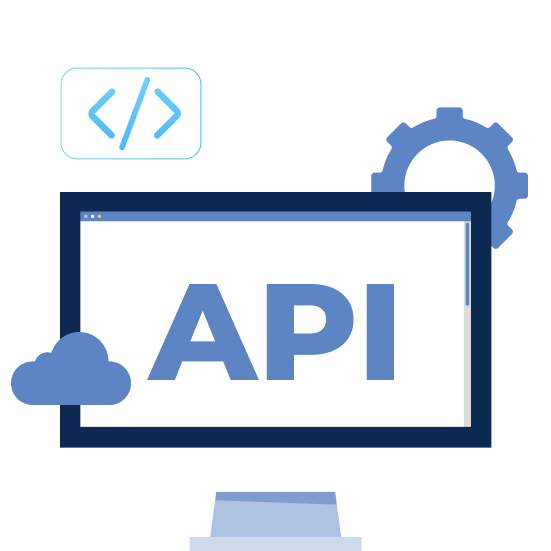The Critical Role of System Integration via API Integration
15/10/2025

Start for free
The challenge your company may face is a fragmented customer experience across multiple internal systems and external communication channels such as WhatsApp, email, or SMS. The solution lies in the unsung heroes—the essential elements to overcome this fragmentation by connecting your internal system directly with a reliable communication platform, creating unified, instant, and integrated communication within your business ecosystem
What Does Connecting Your Internal System to a Communication Solutions Provider Mean?
Connecting your internal system to communication channels means enabling your organization’s system to send and receive various messages directly through an Application Programming Interface (API). In this context, APIs act as a bridge to transmit information between applications, allowing each system to use the functions and data available in the other system.
When this integration is implemented, customer messages automatically reach your system, allowing employees to respond from within the system itself. All conversations and data are stored in a unified database for easy access and analysis. The system can also trigger alerts or perform specific tasks based on incoming messages, such as creating a support ticket or updating an order status. This integration is carried out via a secure and certified connection between the system and the official channel interfaces through a specialized service provider.

The Critical Role of System Integration via API Integration
Types of API Integration
APIs vary according to purpose and the type of integration required. There are public or open APIs accessible to any developer or organization, partner-specific APIs that allow access only to authorized users, internal APIs used for communication between internal enterprise systems, and aggregated APIs that enable multiple requests in a single call, simplifying operations and enhancing integration efficiency between systems.
Overview of Business API Protocols
API protocols represent a set of specifications and design patterns that define how applications communicate with each other. Each protocol relies on a specific structure to meet the needs of different applications, facilitating data exchange and operation execution across systems.
Developers historically relied on protocols like SOAP and RPC to transmit code within local systems and establish robust distributed computing environments, focusing on exchanging XML documents. However, these protocols are rarely used in modern websites, mobile apps, or social media platforms.
In contrast, REST protocols provide greater flexibility and the ability to handle multiple data types over HTTP, enabling efficient text and media transmission with low bandwidth consumption, without permanent server storage, and supporting caching to speed up operations. Similarly, the OData protocol, based on RESTful principles, does not constrain developers with specific URL conventions or media types and uses common formats to facilitate data exchange between systems.
How Does Integration Work?
Within seconds of enabling integration, a customer sends a message via a channel such as WhatsApp, SMS, or email. The message is received through the service provider’s API interfaces, then automatically transmitted to your internal system via Webhooks or direct integration. The message appears in the system for your employee or customer service team, and when a reply is sent from the system, it is automatically delivered to the channel chosen by the customer.
Why Should You Connect Your Company System to a Communication Solutions Provider?
Connecting your internal system with a communication solutions provider is not just about adding a new channel—it’s about building a unified communication ecosystem that links operational data with the customer experience. Every message sent or received becomes part of a digital knowledge base, helping you understand customer behavior, anticipate their needs, and build long-term relationships.
Customers today expect instant responses anytime. Integration with a communication solutions provider ensures every message reaches your internal system for immediate handling, providing a consistent and unified experience across all channels. Conversations can be managed from a single, user-friendly interface, making tracking and analysis easier. Every interaction is documented to give a clear view of the customer lifecycle and behavior, allowing your team to manage all channels from one interface with smart task distribution and fully automated workflows.
Without API integration, software components cannot effectively exchange data, leading to lost, duplicated, or misinterpreted information. API integration opens practical possibilities, such as automating SMS in healthcare and banking for appointment scheduling, confirmations, balance checks, bill payments, and secure, fast access to records.
Examples of Use Cases for System Integration
Integration with Helpdesk Systems
When a customer sends a complaint or inquiry through any channel, a support ticket is automatically created and assigned to the appropriate employee. Once a response is made through the system, the message is delivered directly to the customer, ensuring a seamless experience and organized support management.
Integration with Sales Systems (CRM)
When a new inquiry is received, the system creates a new lead or sales opportunity linked to the customer’s name and current status. This allows the sales team to follow the conversation and convert it into a deal easily. No sales opportunity is lost, and a unified record for each customer is maintained for easy reference and data analysis
Integration with Order Tracking Systems
This integration automatically sends order updates to customers, such as “Your order #458 has been shipped and will arrive within 24 hours” or “Your payment was successfully received, thank you for using our services,” providing communication that enhances customer satisfaction and reduces manual inquiry needs.
Email Marketing Integration
Some platforms integrate with CRM and e-commerce systems, enabling automated email campaigns, personalized marketing, and easy tracking of performance indicators.
Payment Gateway Integration
E-commerce sites often integrate with payment gateways, allowing secure and efficient payment processing directly on the site, improving user experience and offering multiple payment options while ensuring transaction security.
Full ERP Integration
ERP systems connect with various business applications to simplify processes, linking finance, HR, and inventory systems to ensure data consistency and improved efficiency.
Healthcare System Integration
Healthcare systems use APIs to connect electronic health records with different medical applications, ensuring authorized healthcare providers have access to patient data and improving care quality and operational efficiency.
Integration and Consolidation Through Taqnyat API
The basic steps to activate integration with Taqnyat’s multi-channel API solutions:
1- Create an account on a communication channels provider platform
o Taqnyat can assist in issuing the account and linking it to your business number
2- Identify the system you want to integrate
o Whether CRM, ERP, or any internal system
3- Prepare the API integration
o Taqnyat’s technical team sets up the integration with your system
4- Test integration and ensure data flow
o Messages, responses, and delivery statuses are tested
5- Training and operational activation
o Train your team to use the new system and manage unified conversations
Taqnyat provides secure communication as a certified solutions provider by Meta and offers full technical support and ready-made API integration templates
FAQ
